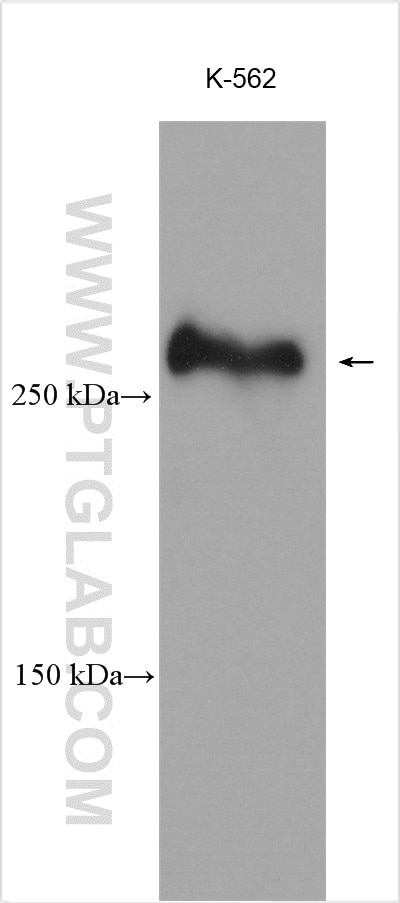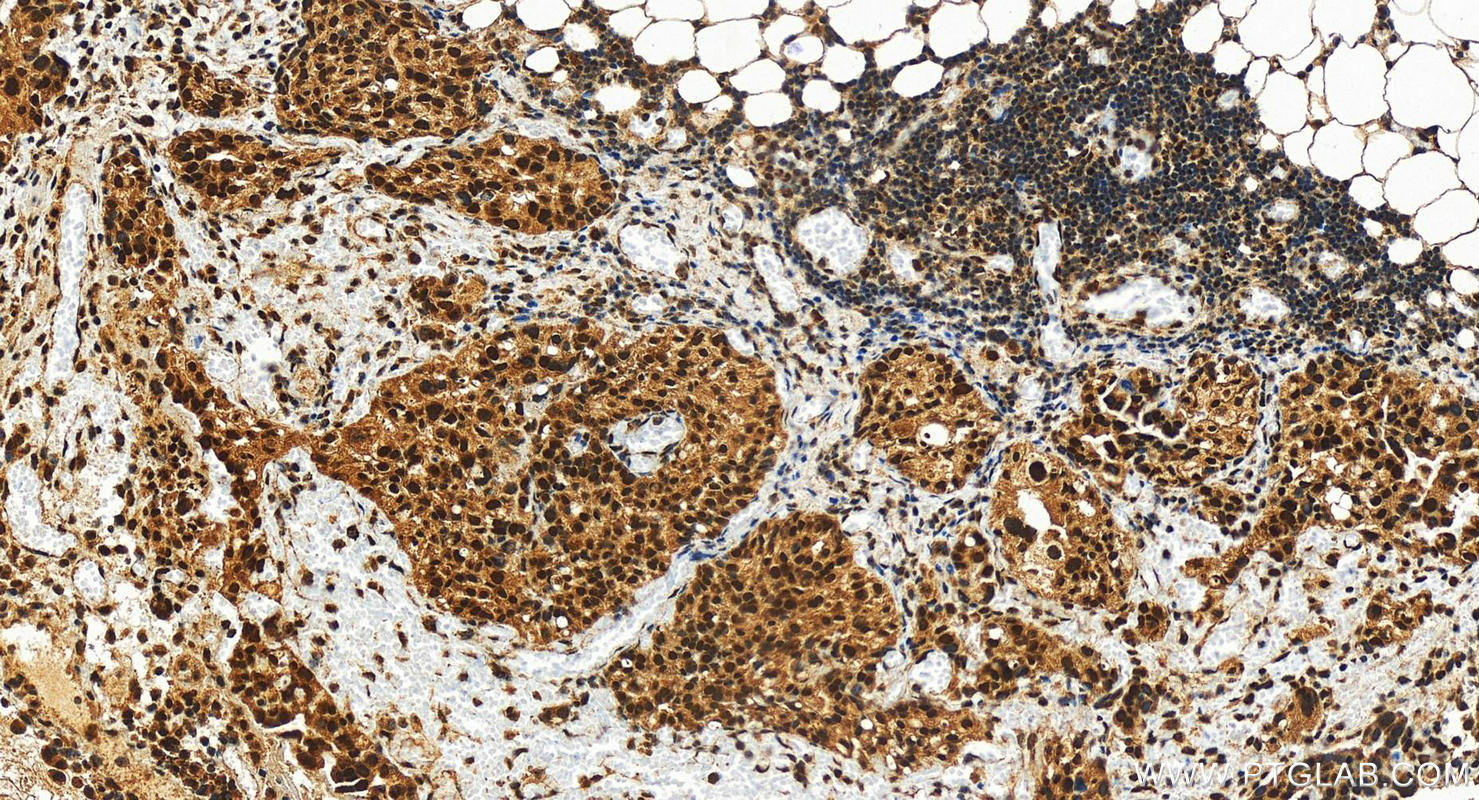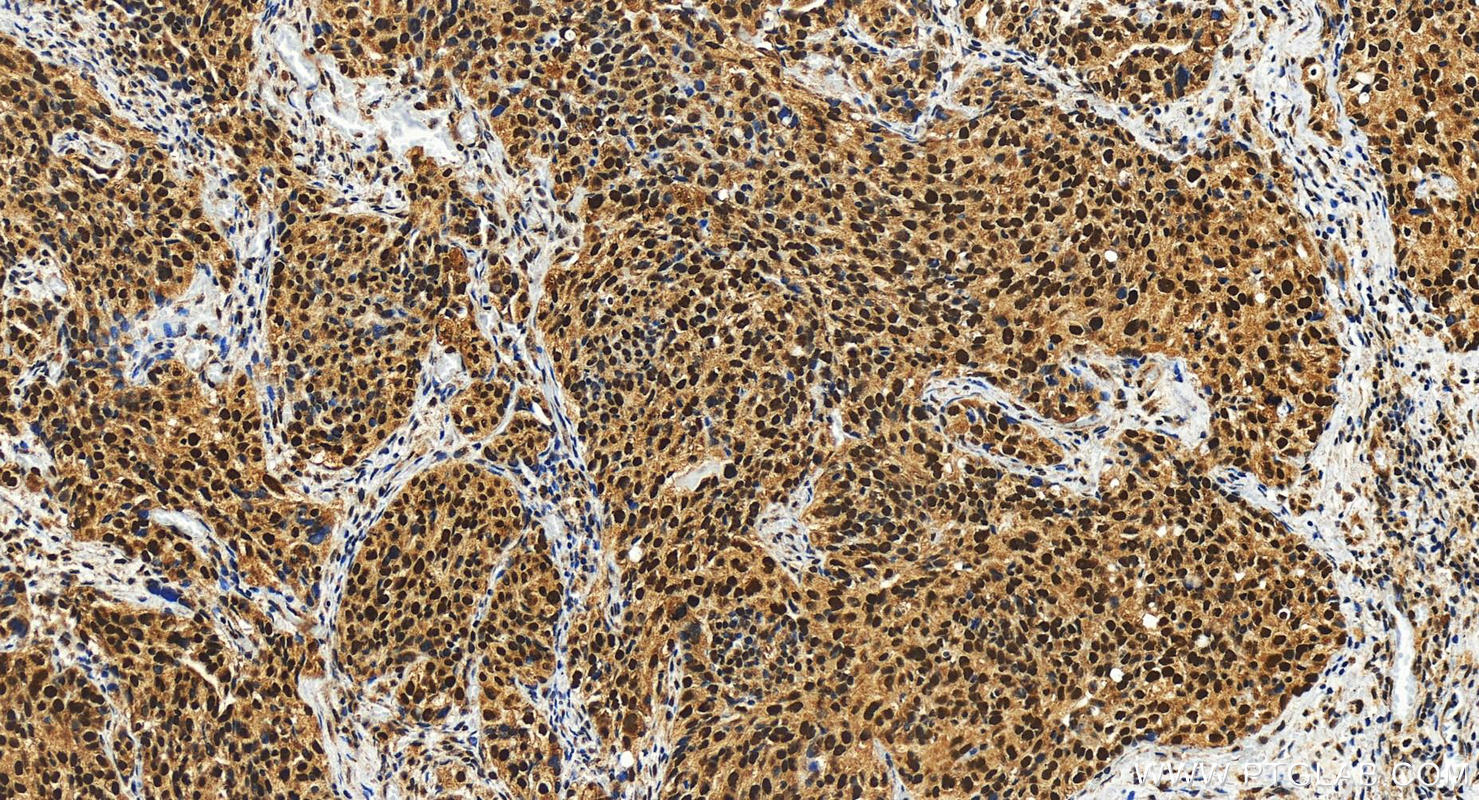KMT2C Polyklonaler Antikörper
KMT2C Polyklonal Antikörper für WB, IHC, ELISA
Wirt / Isotyp
Kaninchen / IgG
Getestete Reaktivität
human
Anwendung
WB, IHC, IF, CoIP, ChIP, ELISA
Konjugation
Unkonjugiert
Kat-Nr. : 28437-1-AP
Synonyme
Geprüfte Anwendungen
| Erfolgreiche Detektion in WB | K-562-Zellen |
| Erfolgreiche Detektion in IHC | human ovary cancer tissue Hinweis: Antigendemaskierung mit TE-Puffer pH 9,0 empfohlen. (*) Wahlweise kann die Antigendemaskierung auch mit Citratpuffer pH 6,0 erfolgen. |
Empfohlene Verdünnung
| Anwendung | Verdünnung |
|---|---|
| Western Blot (WB) | WB : 1:500-1:1000 |
| Immunhistochemie (IHC) | IHC : 1:200-1:800 |
| It is recommended that this reagent should be titrated in each testing system to obtain optimal results. | |
| Sample-dependent, check data in validation data gallery | |
Veröffentlichte Anwendungen
| WB | See 3 publications below |
| IF | See 1 publications below |
| CoIP | See 1 publications below |
| ChIP | See 1 publications below |
Produktinformation
28437-1-AP bindet in WB, IHC, IF, CoIP, ChIP, ELISA KMT2C und zeigt Reaktivität mit human
| Getestete Reaktivität | human |
| In Publikationen genannte Reaktivität | human |
| Wirt / Isotyp | Kaninchen / IgG |
| Klonalität | Polyklonal |
| Typ | Antikörper |
| Immunogen | KMT2C fusion protein Ag28875 |
| Vollständiger Name | myeloid/lymphoid or mixed-lineage leukemia 3 |
| Berechnetes Molekulargewicht | 541 kDa |
| Beobachtetes Molekulargewicht | 541kDa, 269 kDa |
| GenBank-Zugangsnummer | NM_170606 |
| Gene symbol | KMT2C |
| Gene ID (NCBI) | 58508 |
| Konjugation | Unkonjugiert |
| Form | Liquid |
| Reinigungsmethode | Antigen-Affinitätsreinigung |
| Lagerungspuffer | PBS with 0.02% sodium azide and 50% glycerol |
| Lagerungsbedingungen | Bei -20°C lagern. Nach dem Versand ein Jahr lang stabil Aliquotieren ist bei -20oC Lagerung nicht notwendig. 20ul Größen enthalten 0,1% BSA. |
Hintergrundinformationen
Lysine (K)-specific methyltransferase 2C (KMT2C, also known as MLL3) belongs to the mixed-lineage leukemia (MLL) family of histone methyltransferases which methylate the histone 3 tail at lysine 4 (H3K4) as part of the complex proteins associated with Set 1 (COMPASS) complex. Although originally identified as oncogenic fusions in leukemia, genome-wide mutation studies have revealed frequent, presumably loss-of-function, mutations in various members of the MLL family, including MLL2/KMT2B, MLL3/KMT2C, and MLL4/KMT2D in a variety of malignancies, particularly solid tumors. Mechanistic studies of KMT2C in normal cells have focused primarily on its role in enhancer regulation by deposition of H3K4me1 marks.
Protokolle
| PRODUKTSPEZIFISCHE PROTOKOLLE | |
|---|---|
| WB protocol for KMT2C antibody 28437-1-AP | Protokoll herunterladen |
| IHC protocol for KMT2C antibody 28437-1-AP | Protokoll herunterladenl |
| STANDARD-PROTOKOLLE | |
|---|---|
| Klicken Sie hier, um unsere Standardprotokolle anzuzeigen |
Publikationen
| Species | Application | Title |
|---|---|---|
Int Immunopharmacol Polysaccharides from Platycodonis Radix ameliorated respiratory syncytial virus-induced epithelial cell apoptosis and inflammation through activation of miR-181a-mediated Hippo and SIRT1 pathways. | ||
J Biol Chem TRIM28 represses renal cell carcinoma cell proliferation by inhibiting TFE3/KDM6A-regulated autophagy | ||
Adv Sci (Weinh) TAOK3 Facilitates Esophageal Squamous Cell Carcinoma Progression and Cisplatin Resistance Through Augmenting Autophagy Mediated by IRGM | ||
Nat Chem Biol UFL1 triggers replication fork degradation by MRE11 in BRCA1/2-deficient cells | ||
BMC Med Genomics Clinical characteristics and genetic analysis of four pediatric patients with Kleefstra syndrome |




